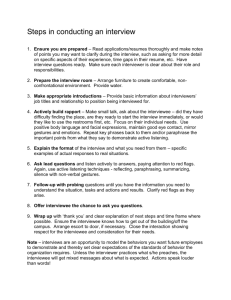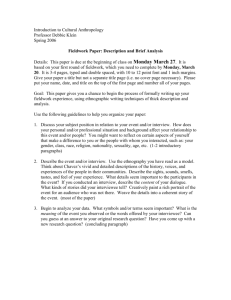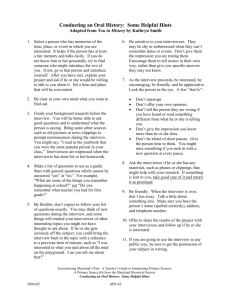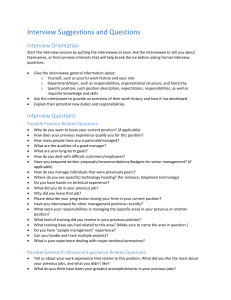Interviewing
advertisement
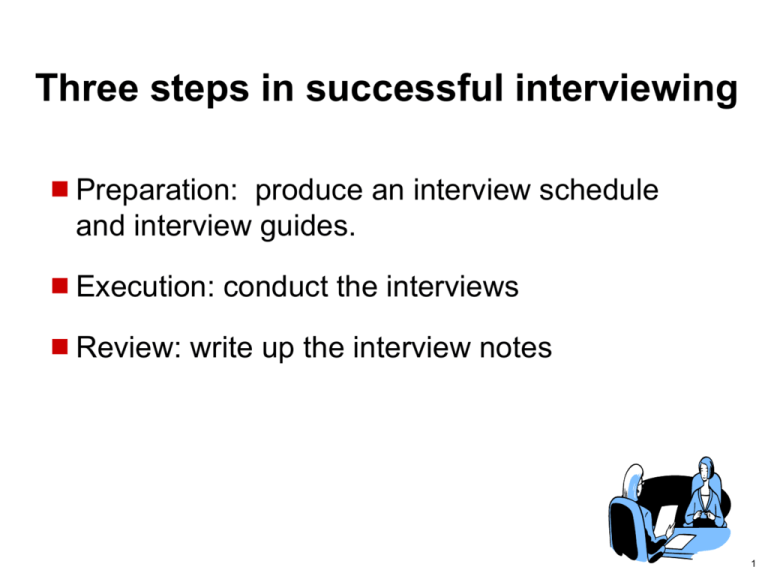
Three steps in successful interviewing Preparation: produce an interview schedule and interview guides. Execution: conduct the interviews Review: write up the interview notes 1 Steps in the interview process Preparation Interview schedule Who you are going to interview, why, when and where? Interview guides What questions are you going to ask? Execution Review Interview Interview notes format • Structure • Rapport • Listen • Probe • Clarify What results were obtained? • Information found • Decisions • Actions An interview guide should be created prior to all interviews to ensure the interviews are focused and efficient and enable comparison and summarisation. 2 The interview schedule Name Position Rationale Date John Smith R&D Manager To understand R&D strategy 25/4 and get future R&D expenditures Roy Wilkinson Head of metalurgical research To get facts on competitor Xs latest development. In particular: Potential customers Our position Bob Johnson Lab assistant 27/4 An interview schedule is helpful, to track who is going to be interviewed, when and why. 3 Preparing the interview schedule • Identify what the objectives of the interviews are, what information you need to find out and therefore what areas of the business you need to obtain information from. • Identify who needs to be interviewed to obtain this information. • Create an interview schedule, allowing time to review and record notes between interviews. • Book the interviews and record them in the schedule. 4 The interview guide Section Question Introduction 1. Personal background Sub Question Education 2. Key mission of the department Work experience 3. …………….. Major activities Major interfaces Body 4. Recent development in area x Major products 5. Customer reactions Competitor activities 6. ………………. Wrap up 7. ………………. Switching costs Timing of change 8. ………………. 9. Future trends Next S - curve Timing 10.Restate key points To make the most out of an interview, a well thought through interview guide is extremely helpful. 5 Preparing the interview guide • • • • Determine the objectives of the interview. Plan the structure of the interview. Prepare interview questions. Prepare additional notes if they assist. For example having an organisation chart helps in clarifying roles and responsibilities. The interview guide enables standardisation of interviews for effective comparison and summarisation 6 Guidelines for structuring an interview Focused Many interviewees tend to go ‘off on tangents’ during interviews. Your interview guide should clearly state the boundaries for your interview. These should be stated generally at the beginning with more specific instructions to refocus when appropriate. Quantifiable Open questions tend to produce long answers that are difficult to quantify and compare. If you need measured responses ask the interviewee to assign a value to their answer so direct comparisons to be made. For example How reliable is the current system, what score would you give it out of ten? Complete Check that the guide addresses all the objectives of the interview and have a colleague review it. 7 How to conduct the interview Introduction Conduct at their place of work where possible Always state the reason for the interview and how it will be conducted Put the interviewee at ease Ask the interviewee if they agree to you taking notes Body Listen to the answers and request clarification if necessary Avoid making criticisms or taking sides Keep control of the interview: refocus the interviewee if they are rambling or clarify if they misunderstood the question Stay focused and follow your interview guide Allow the interviewee to ask questions Wrap-up Thank the interviewee Advise them what the next steps are and the timeframe 8 Build rapport Your interview needs to balance the building of rapport and collecting of required information. Introduction Gain rapport first. Explain the context, set the tone, and make the interviewee feel at ease. The introduction serves to: • Introduce yourself • Gauge the interviewee’s style, expectations and concerns • Confirm the timeframe Sequence the interview items Items should be ordered by importance and sensitivity. The more sensitive your interviewee, the more important it is to avoid an ‘inquisitorial’ interview tone. A non-threatening format for interviews involves the careful arrangement of interview topics: • General before specific • External before internal • Historic before current 9 Listen and question Listen To reassure the interviewee you are listening and to gain information: • use non-verbal cues such as head nods to show you are listening. • wait until the current question is answered before preparing the next one • listen for emotions and attitudes as well as facts • interrupt only if you sense avoidance of answering the question or if the interviewee has drifted too far from the topic • request clarification and ask follow on questions Ask open questions To initiate discussion on a broad subject and to encourage a comprehensive explanation: • use clear, direct phrasing that asks a single question • ask how, what or when but avoid the intimidating why question Ask closed questions To elicit a specific reply: • use this type of question sparingly to avoid appearing as an interrogator • ask in order to understand rather than impress • be concise 10 Open questioning Examples: “So what do you enjoy about the role?” “Are there any other issues I should be aware of?” Advantages • • • • Puts interviewee at ease Interesting for interviewee Provides depth of detail Reveals other areas of enquiry Disadvantages • You may lose control • May use up too much time • Interviewer may appear unprepared • Harder to analyse later • Lower reliability of data 11 Closed questioning Examples: “Is the new form better or worse than the old form?” “Is it Mary or Jane who enter the application details?” “Do you stamp the form before or after the details are recorded? Advantages • • • • • Efficient use of time Easy to compare interviews Higher reliability of data Less interviewing skill needed Disadvantages • • • Can be boring for interviewees Doesn’t provide the opportunity to qualify answers You may miss other areas Focuses interviewee 12 Probe questioning Probe questioning is honing in on a particular area of interest and drilling down to obtain more detail. It includes asking for more information to clarify a vague phrase or statement made by the interviewee such as ‘quite high’ or ‘often late’. Probe questioning needs to be balanced with open and closed questioning to avoid the interview seeming like an interrogation. Examples: “How does that happen?” “How did that change impact your department?” “What specifically do they do as a result of that?” Advantages Disadvantages • Provides data on new aspects • Supplies detail in context • Shows interest in conversation • Can appear threatening 13 Paraphrasing Paraphrasing is a technique used to confirm or clarify something the interviewee has said or implied. There are three levels of paraphrasing: 1. The first level confirms or clarifies expressed thoughts and feelings, for example: “so there are three factors that determine the present situation” 2. The second confirms implied thoughts or feelings, for example: “so you would really like to change this situation” 3. The third surfaces core thoughts or feelings, for example: “you are afraid that it might make things worse for you” or “so you think the strategy is wrong” (Note that with paraphrasing of feelings you can trigger a strong emotional response particularly with this third option ) 14 Interview review A standard interview note format is useful in orienting interviews to results: Key Steps • Write interview notes as soon as possible after the interview • Outline key findings, note emerging hypotheses • Consider how findings fit with earlier evidence • Identify gaps to be filled in subsequent interviews Format Interview Notes Interviewees: Interviewers: Location: Date: KEY FINDINGS BACKGROUND AND SITUATION DISCUSSION NOTES NEXT STEPS Interview notes are valuable when sharing information with other team members. 15 Adjust your style to suit the interviewee The nervous interviewee Be very explicit in setting the scene, tell why you are there and what they can expect. Establish rapport and make sure you are relaxed and confident The non-talker Make a special effort to build rapport and find common language and experiences. Avoid closed questions, use open questions to draw them out The angry/hostile interviewee Do not tolerate threatening behaviour. If anger is directed at you: • admit your mistake if you are wrong • stay calm, avoid getting angry in return If anger is directed at others: • do not get involved and do not taking sides • correct misinformation tactfully ie do not challenge honestly held opinions 16 Poor interviewing behaviour Examples: × × × × × × × × × × × × Did not make an appointment Arrived late Was rude Exhibited one upmanship Did not explain the purpose of the interview Did not explain the scope of interview Used jargon Became confrontational Was inconsiderate Talked down to the interviewee Abruptly ended the interview Did not explain what happens next 17 Do not × × × × × × × × × × Arrive without warning Forget interviewee’s name or role Show off Criticise Interrupt Be impatient Use coarse language Fidget, lounge or appear bored Go over time without agreement from interviewee Fail to thank the interviewee for their time 18 Do Create rapport Make notes Be sincere Be objective Be courteous Verify your findings Separate fact from fiction Pitch the interview at the right level Keep within the scope of the interview Establish the option to ask follow up questions Wrap up the interview and thank the interviewee for their time. 19
